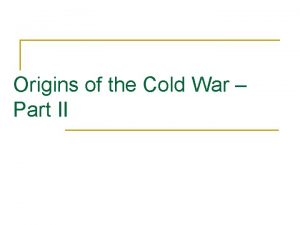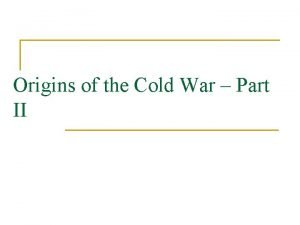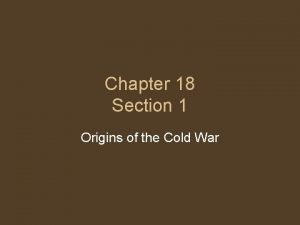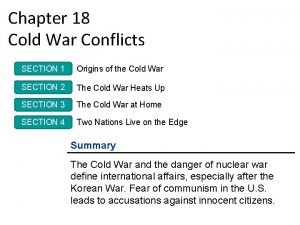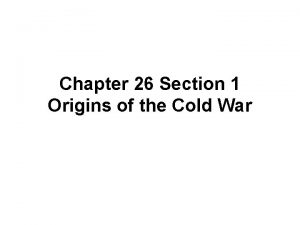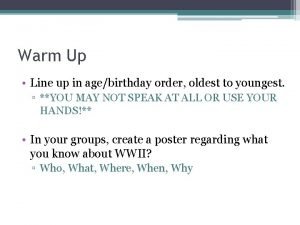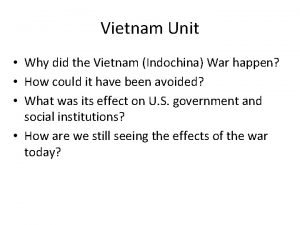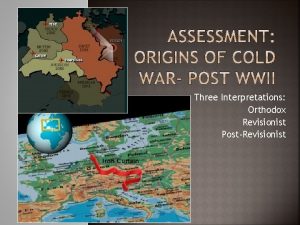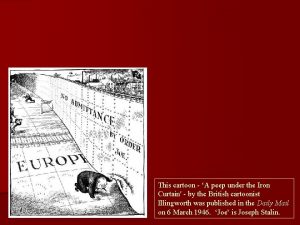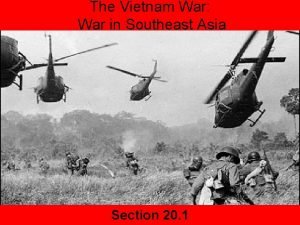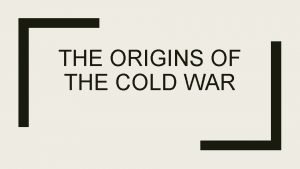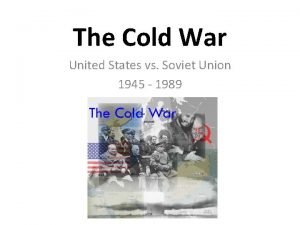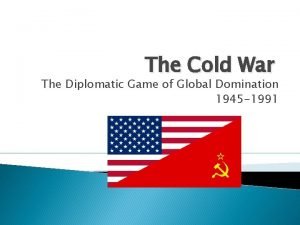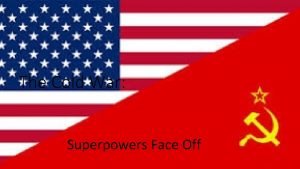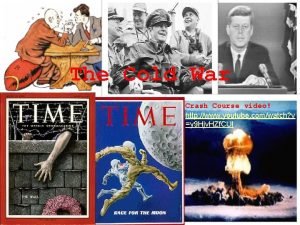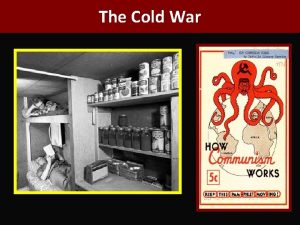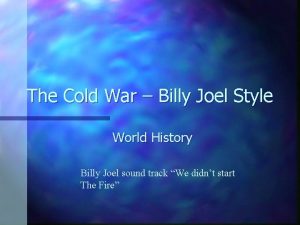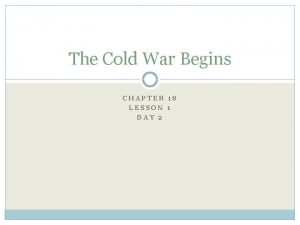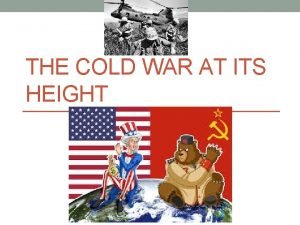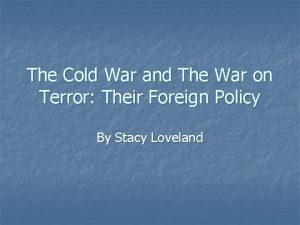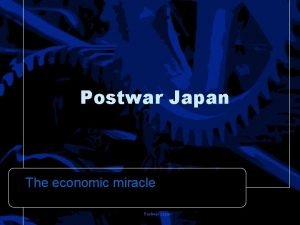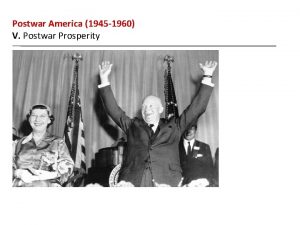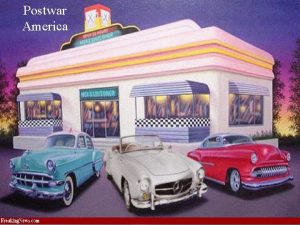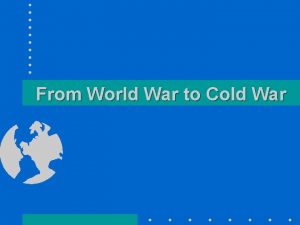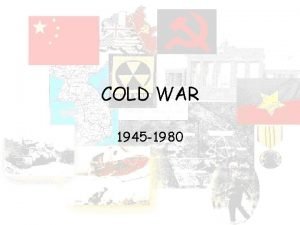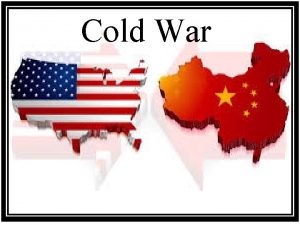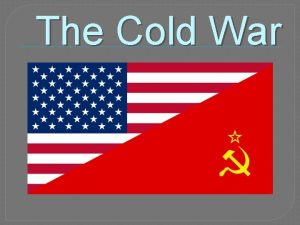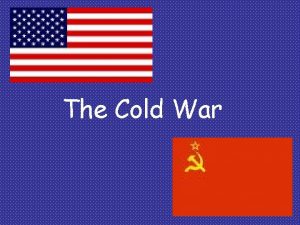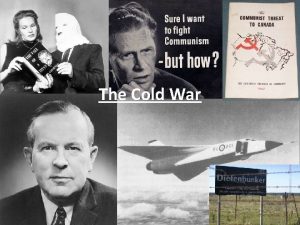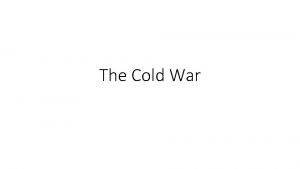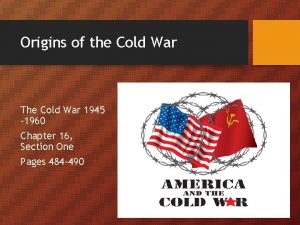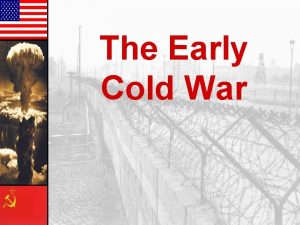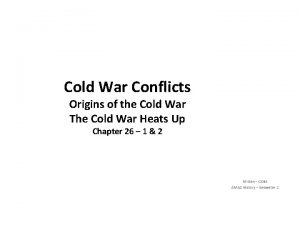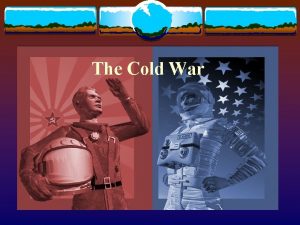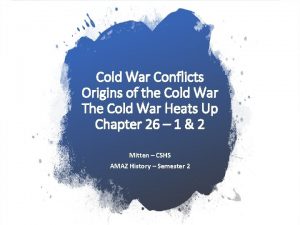The Postwar World Origins of the Cold War





















- Slides: 21

The Postwar World & Origins of the Cold War Mr. Ermer U. S. History Miami Beach Senior High

Origins of the Cold War ► U. S. & Soviets have different views of how postwar world should look § The Atlantic Charter (1941) Nations should solve problems through diplomacy—through an international organization—and nations of the world should be free w/ self determination ► Signed by United States, Great Britain, and Soviet Union (U. S. S. R. ) ► Soviets secretly want to take control of Eastern Europe after war ► British nervous about what A. C. means for their worldwide empire § Churchill and Stalin want the great powers to control different “spheres of influence” ► Casablanca Conf: Agree for total surrender of Axis ► Teheran Conf: Soviets agree to help with Japan after European war ends, disagreement over Poland’s future

The Yalta Conference ► The Big Three meet in February 1945 ► Roosevelt seeks Soviet help with Japan § Promises Japanese land to Stalin in exchange ► Creation of a new United Nations § Security Council: US, UK, France, USSR, China § First meeting set for April 1945 in San Francisco ► After war Germany to be split into four sectors controlled by US, UK, USSR & France, based on troop placement at the end of the war § Berlin too would be divided into four sectors ► Future of Poland left uncertain § Soviets already held Poland, installed pro-communist gov’t


Potsdam and New Struggles ► Truman, now president, not as familiar with international politics as FDR, uses “Get Tough Policy” § FDR believed Stalin would ultimately listen to reason, Truman did not trust Russians in general, and was suspicious of Stalin ► July 1945: Potsdam Conference, Germany Truman demands elections for all of Europe, fails Stalin wins battle to move Polish border into German territory Truman convinces Stalin to accept no reparations from Allied controlled parts of Germany, assuring Germany would stay split § Big Three agree to trials of Nazi war criminals in Nuremberg, Germany(1945 -1946) § § § ► Churchill: “iron curtain has descended on the continent” splitting Europe east/west



Two Super Powers ► After WWII, USA and Soviet Union emerge as superpowers § unrivaled military, political, & economic power Disagreements over how to rebuild post-war Europe breeds mistrust ► 1947: Truman Doctrine ► § The United States will help any country fight Communism ► Supported by the writings of diplomat George Kennan § Born from a fear of Soviet influence in the developing world

The Marshall Plan ► Motivations for helping Europe after the war: § § Humanitarian concern for Europeans affected by war Concern that Europe would be a drain on the U. S. economy A recovered Europe would provide a market for American products Strengthen pro-American, anti-Communist governments in Europe ► ► 1948 Communist coup in Czechoslovakia galvanizes American public support U. S. Secretary of State George C. Marshall offers plan: § Offered to all European nations, including Russia § Congress creates Economic Cooperation Administration ► $12 Billion in U. S. aid to European countries that accept Marshall Plan § U. S. companies help finance and rebuild European countries ► European industrial production increases by 64% by end of 1950 § Keeps populations happy, Communism remains unpopular ► Soviet satellite states refuse American help § Soviet plans to help failed, not enough money available


Division of Germany ► According to Yalta & Potsdam agreements Germany divided § United States, Soviet Union, U. K. & France split control over zones ► Berlin, German capital, also split in four § Berlin was located deep in Soviet East Germany ► West Germany united, Soviets blockade West Berlin § Soviets block supplies from reaching W. Berlin § Soviets hope to take control of entire city of Berlin ► Berlin Air Lift: supplies are flown into West Berlin by U. S. Air Force

Division of Germany


Containment & the Bi-Polar World ► Policy of Containment: United States vow to keep Communism from spreading past its current boundaries, fight against Soviet aggression. § Communist government comes to power in Yugoslavia § U. S. helps Greece fight against Communist revolution § U. S. helps Turkey defeat Communist rebels ► The world splits into Communist and Anti-Communist alliances: § NATO (North Atlantic Treaty Organization): U. S. , U. K. , Belgium, Lux, France, The Neth. , Italy, Denmark, Norway, Portugal, Iceland, Canada, W. Germany, Turkey, Greece § Warsaw Pact: U. S. S. R. & Eastern European “Communist Block” ► By 1950 s, USA allied with 42 nations against Communism


Containment in Asia Rebuilding Japan seen as way of hedging American influence against Communist advances in China ► Chiang Kai-shek’s nationalist government is friendly to U. S. interests, but corrupt, incompetent, and unpopular in China ► § Mao Zedong’s Communist forces gaining strength & popularity § United States seeks a “third force” to support ► Civil War erupts in China, Truman supports Chiang § Marshall maintains full out U. S. war in China only way Chiang can win, does not recommend fighting in China—Mao ultimately wins ► 1949: Communist government established in China § Chiang and his allies flee to island of Formosa (Taiwan), U. S. support § United States does not recognize Mao’s Communist China ► Japan and Taiwan stand in American sphere of influence § Hope for open, prosperous, democratic China fades


Cold War Heats Up 1948: Truman revives Selective Service System, draft ► 1949: Soviets detonate an atomic bomb ► Arms Race: Soviets and Americans build up militaries and weapons, improve bombs ► § § 1946: Atomic Energy Commission created 1947: Congress passes the National Security Act ► Created Department of Defense to handle all military activities ► Created National Security Council (NSC) to oversee policy from White House ► Created Central Intelligence Agency (CIA) as spy organization § 1950: Truman approves creation of the Hydrogen Bomb § 1950: National Security Council issues a report (NSC-68) toughening containment policy, the U. S. could no longer depend on other countries to help in containment, be the aggressor

Berlin Wall ► Arms race builds steam with hydrogen bomb, ICBMs and stronger nukes ► 1957: Soviet Sputnik I reaches space § USA believes it’s losing space race/arms race § 1958: NASA created to compete with Soviet space program ► Nikita Khrushchev, new Soviet leader, sees problem with East Germans escaping to the much richer, freer West Berlin § Soviets build a wall around West Berlin to prevent escape


►On page 329, write and answer questions 1 -4
 Lesson 1 the origins of the cold war
Lesson 1 the origins of the cold war Origins of the cold war
Origins of the cold war Origins of the cold war
Origins of the cold war Chapter 18 section 1 origins of the cold war
Chapter 18 section 1 origins of the cold war Origins of the cold war chapter 18 section 1
Origins of the cold war chapter 18 section 1 Chapter 26 section 1 origins of the cold war
Chapter 26 section 1 origins of the cold war Proxy war cold war definition
Proxy war cold war definition Soviet union acrostic poem examples
Soviet union acrostic poem examples Napalm vietnam war
Napalm vietnam war Postrevisionist
Postrevisionist Peep under the iron curtain meaning
Peep under the iron curtain meaning Operation rolling thunder cold war
Operation rolling thunder cold war Cause of the cold war
Cause of the cold war Soviet
Soviet Effects of cold war
Effects of cold war Superpowers cold war
Superpowers cold war Cold war crash course
Cold war crash course What were the characteristics of the cold war
What were the characteristics of the cold war Mafia hula hoops
Mafia hula hoops Lesson 1 the cold war begins
Lesson 1 the cold war begins Cold war at its height quiz
Cold war at its height quiz Who was involved in the cold war
Who was involved in the cold war

